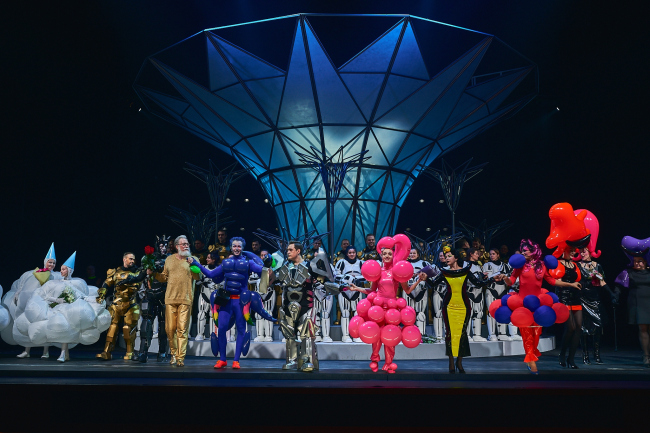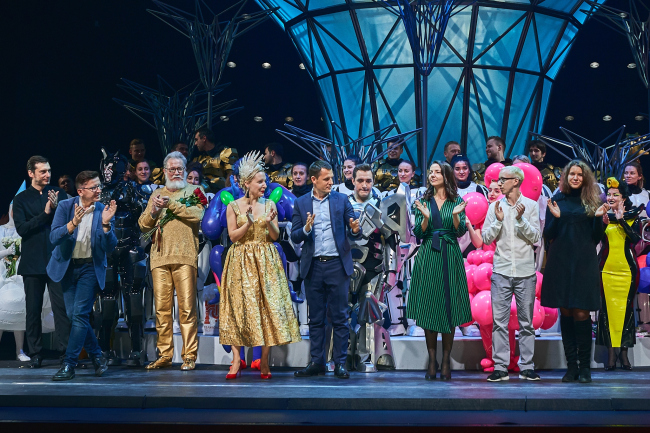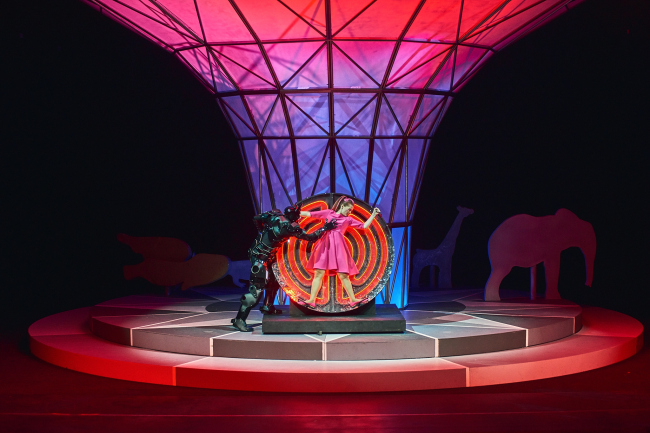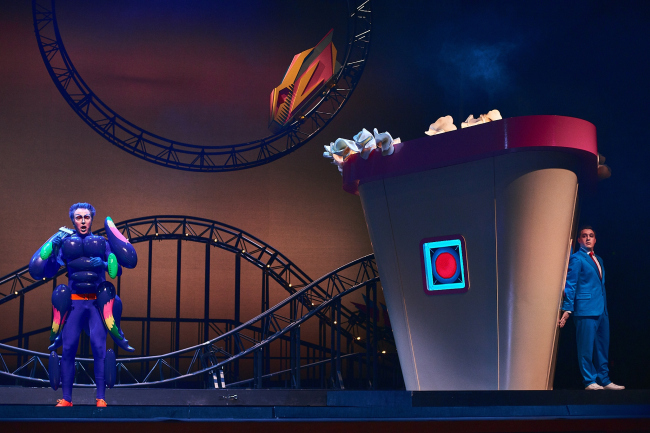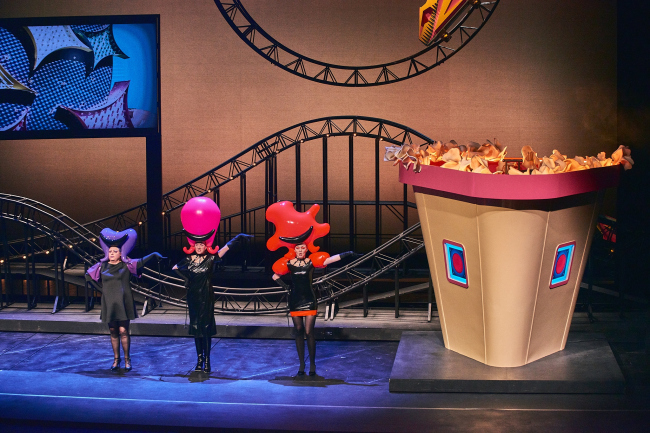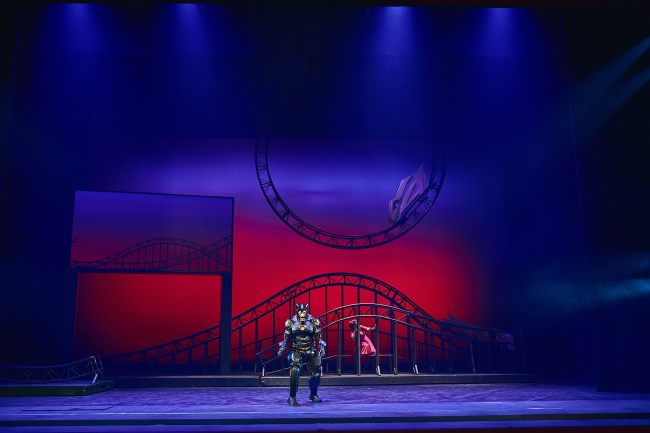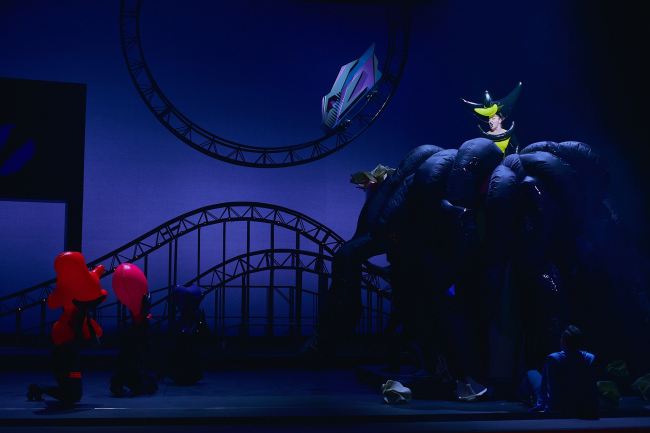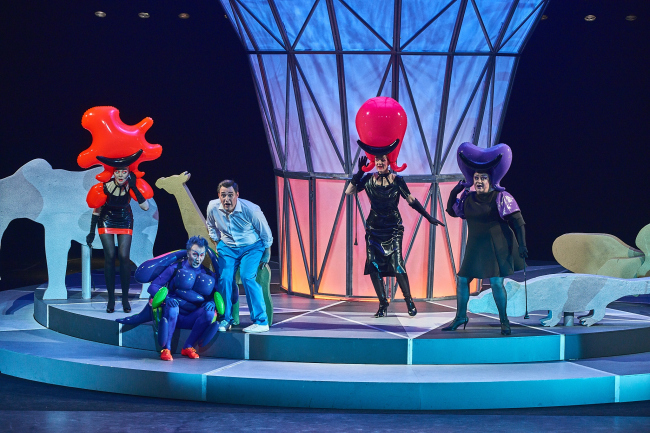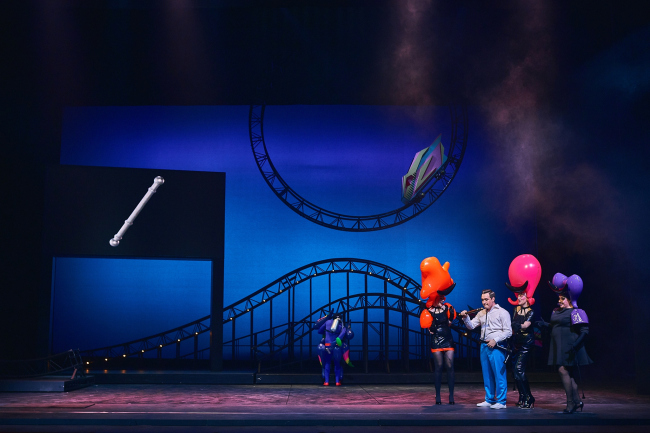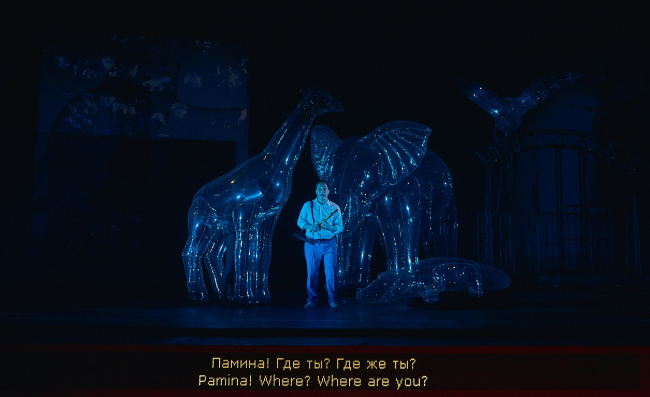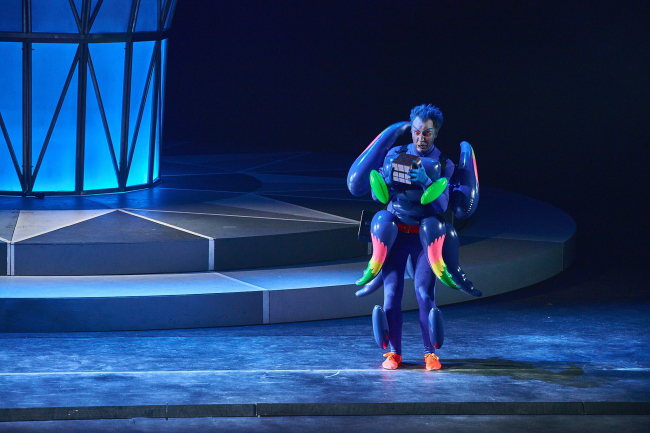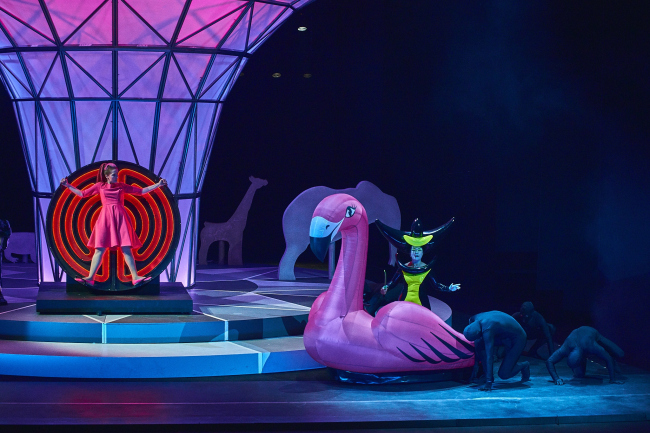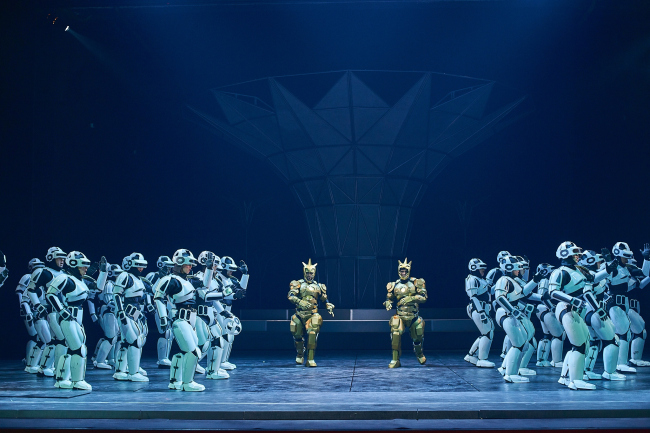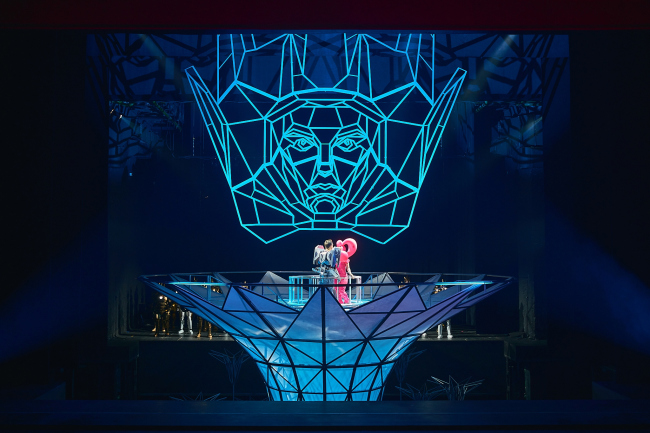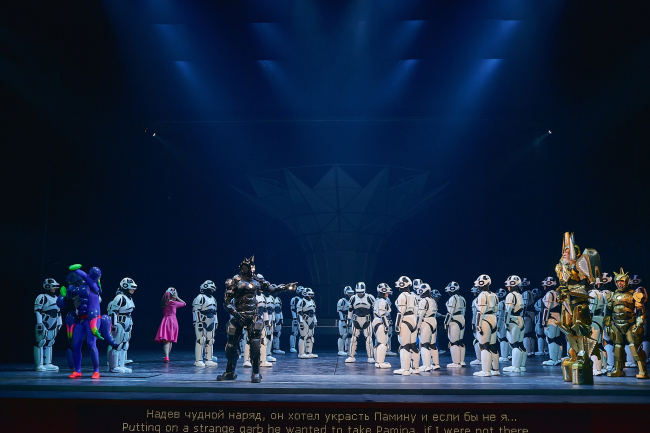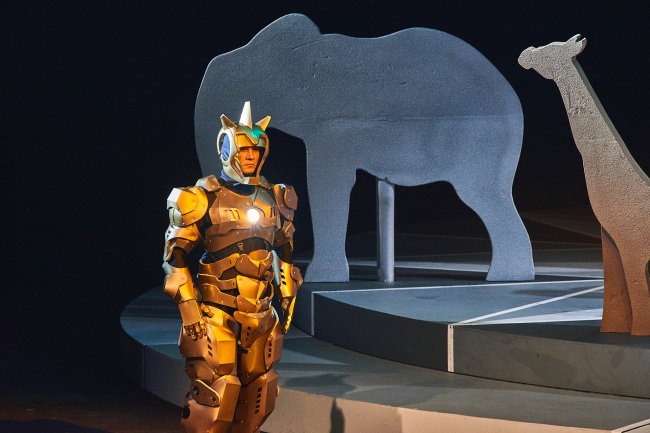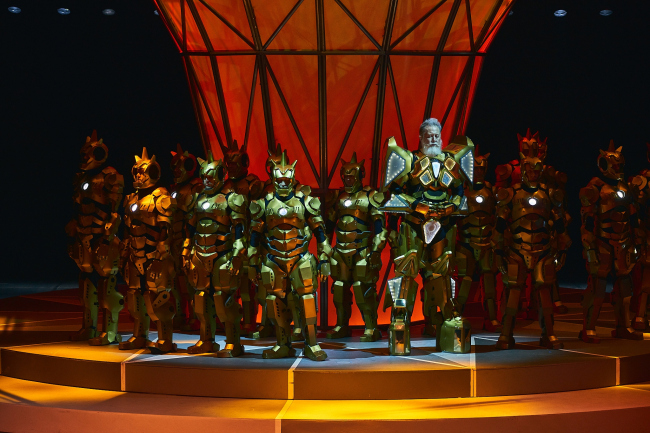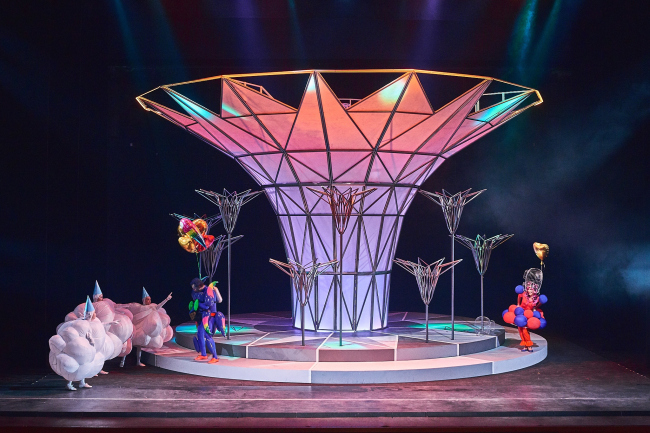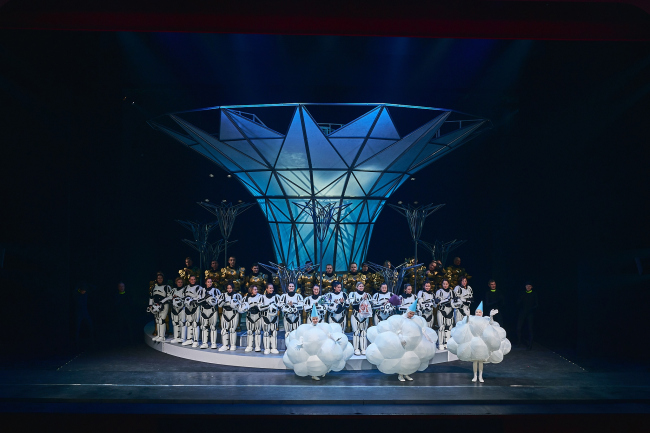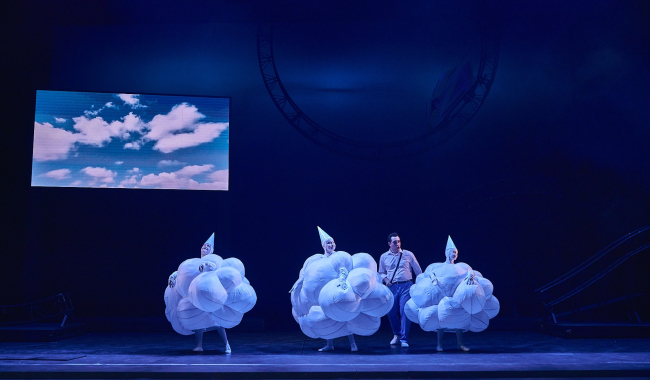|
Published on Archi.ru (https://archi.ru) |
|
| 19.11.2018 | |
|
Carousel. Tree. Tower. |
|
|
Lara Kopylova |
|
| Architect: | |
| Sergey Kouznetsov | |
|
The premier of “The Magic Flute” (Die Zauberflöte) by Wolfgang Amadeus Mozart in the scenery designed by Sergey Kuznetsov and Agnia Sterligova (Planet 9) in “Helikon-Opera” is a pure delight for adults and children alike (the opera is staged in two versions). The stage design is the core, upon which is strung the wild narrative about the controversy between the feminine and masculine. Stage design of “The Magic Flute” in “Helikon-Opera”. Production designers: Sergey Kuznetsov, Agnia Sterligova. Photograph © Sergey KrotovThis opera includes everything one can possibly think of: a quest and a Christmas show for children, ancient symbols and myths seen through the prism of psychoanalysis, picaresque romance and masonic themes, the subtleties of gender relations, and, of course, the celestial Mozart choirs that sound just short of the whole audience joining in, like you would expect at a rock concert. The loving couple goes through a terrible ordeal only to be together, and once they are together at last, they go through more ordeals, just as terrible. Everyone loves everyone, everybody saves everybody, lots of them want to kill one another or themselves but finally everybody ends up loving everybody all the same. For the Chief Architect of Moscow, Sergey Kuznetsov, this is his second project that he did in the capacity of a production designer (the first was the premier of “Helikon-Opera” after it was reconstructed in 2015). His coauthor, Agnia Sterligova (Planet 9) already has some experience in stage design. At the press conference before the premiere of “The Flute” that took place November 12, the authors of the performance shared their impressions. Premier of “The Magic Flute” in “Helikon-Opera”. Photograph © Sergey KrotovAccording to Sergey Kuznetsov, he and Agnia Sterligova proceeded not so much from the music as from the stage design tradition, watched a lot of material, and did not want to repeat something that already was done before them. “This is a show that teeters on the verge of pop art and kitsch yet does not overstep the mark; a show that will leave nobody indifferent. Mozart would have been pleased – recapped the chief architect – This is a meditation on the conflict between man’s and woman’s worlds and about how they are attracted to each other, which affects all of us. Any living creature can associate itself with this or that gender. Well, those who definitely can, they will surely find this interesting, and as for the others, well, maybe they will stop to think for a second and will finally make up their minds. We believe that after this performance everyone will be absolutely certain on this issue”. Agnia Sterligova was more specific about the idea: “In the dialogue with the production director, Ilia Iliyn, we came up with the image of a Luna Park, the kind that they had in the beginning of the ŐŐ century in New York’s Coney Island. This choice was motivated by the pop art inflatable costumes designed by Alexandra Sharova. The controversy between man’s and woman’s world was shown against the backdrop of a grand-scale spinning carousel, this carousel also being the Temple of Wisdom”. And the producer of “Helikon-Opera”, Dmitry Bertman, made an important speech about the role of architecture. He said: “We have been friends with Sergey Kuznetsov for years; he designed the exposition for the opening ceremony of our theater, and we were thinking about producing “The Flute” for quite a while. In spite of his high status, Sergei Kuznetsov is not a “government official” at all, he is quite the reverse, and he is a true artist. Modern theater is essentially symbolic – the age of imitation is over, and it’s not about a “painted veil” anymore. Today, it’s the architects who come out on stage, we see this in theaters all around the world”. The curtain of “The Magic Flute” with a watercolor painting by Sergey Kuznetsov. Photograph © Sergey KrotovIn spite of my musical background, I could never not so much as make sense of but even remember the storyline of “The Magic Flute”, and focused solely on the music. Why does the wizard Sarastro (a reference to the fire worshipper Zarathustra, I presume) summon the Egyptian Isis and Osiris? They seem to be from different pages of history, do they not? The masonic librettist Schikaneder (he is also the first performer of Papageno) hints at some secret knowledge of the Ancient Greece that was passed on to the Freemasonry – but what does Persia have to do with it? Why did the Persian sage steal the princess? As it turned out, to teach her wisdom, not to marry her. If this is to be the case, then why does he leave her guarded by the blackamoor who literally harasses her (or is this the narrative of the beauty and the beast that somehow popped up along the way?) Stage design of “The Magic Flute” in “Helikon-Opera”. Production designers: Sergey Kuznetsov, Agnia Sterligova. Photograph © Sergey KrotovStage design of “The Magic Flute” in “Helikon-Opera”. Production designers: Sergey Kuznetsov, Agnia Sterligova. Photograph © Sergey KrotovStage design of “The Magic Flute” in “Helikon-Opera”. Production designers: Sergey Kuznetsov, Agnia Sterligova. Photograph © Sergey KrotovStage design of “The Magic Flute” in “Helikon-Opera”. Production designers: Sergey Kuznetsov, Agnia Sterligova. Photograph © Sergey KrotovBefore the beginning of the performance, we see the curtain demonstrating a water color painting by Sergey Kuznetsov that shows a carousel that also looks like a chandelier that starts to beautifully give off smoke, its colors starting to run, during the overture. Then the curtain goes up, and we find ourselves in the Luna Park, where anything can happen: terrible danger and breathtaking adventures are on the way. In the first act, there is a rollercoaster on stage, upon which a train tears back and forth – but, instead of a train, this turns out to be the serpent chasing Prince Tamino. The serpent almost got him but at the very last moment the prince was saved by three infernal-looking ladies dressed in black and red – the fairies or the “attendants” of the Queen of the Night. Stage design of “The Magic Flute” in “Helikon-Opera”. Production designers: Sergey Kuznetsov, Agnia Sterligova. Photograph © Sergey KrotovIn Luna Park, we are in for both market square performances and quests that we have to take a part in. And it is not accidental that the Queen of the Night crawls out from a popcorn cup, while the snakes upon which she rests (not really scary-looking because they are inflatables) minimize the fanfare of the world’s most difficult aria, which includes an F-note of the third octave. (The aria, incidentally, did sound really beautiful, just as Tamino’s tenor part and the Grandfather’s bass part did). Generally, they sing with finesse, easily tackling Mozart’s “instrumental” barely singable tunes, the orchestra plays tastefully, and it’s a rare treat for one’s ears… but I digress. Stage design of “The Magic Flute” in “Helikon-Opera”. Production designers: Sergey Kuznetsov, Agnia Sterligova. Photograph © Sergey KrotovStage design of “The Magic Flute” in “Helikon-Opera”. Production designers: Sergey Kuznetsov, Agnia Sterligova. Photograph © Sergey KrotovStage design of “The Magic Flute” in “Helikon-Opera”. Production designers: Sergey Kuznetsov, Agnia Sterligova. Photograph © Sergey KrotovStage design of “The Magic Flute” in “Helikon-Opera”. Production designers: Sergey Kuznetsov, Agnia Sterligova. Photograph © Sergey KrotovThe stage design of “The Magic Flute” is centered around some universal tree that shows different colors: it crackles in flames when the heroes have to go through the fire, it turns blue and starts bubbling when they go through the water, and it shines pure gold in the temple of Sarastro (I only learned about the fact that this is a “carousel” after I wrote the review but the associations with the biblical tree of knowledge of good and evil only make it more beautiful because it comes to knowing the depths of human nature and enlightenment thereof). The shape and the metallic structures of the tree look like the bell of the Shukhov Tower, something you might call a “constructivist church bell” of sorts (and, getting ahead of myself, I will say that later on it will be surrounded by little constructivist bells growing around it). This tower tightly holds the composition together, it is always in the center, it is always prevailing, it helps to arrange the choreography, rotating on a turntable during the change of scenery. The media screen in the left part of the stage comments on the things that are going on. Stage design of “The Magic Flute” in “Helikon-Opera”. Production designers: Sergey Kuznetsov, Agnia Sterligova. Photograph © Sergey KrotovStage design of “The Magic Flute” in “Helikon-Opera”. Production designers: Sergey Kuznetsov, Agnia Sterligova. Photograph © Sergey KrotovStage design of “The Magic Flute” in “Helikon-Opera”. Production designers: Sergey Kuznetsov, Agnia Sterligova. Photograph © Sergey KrotovStage design of “The Magic Flute” in “Helikon-Opera”. Production designers: Sergey Kuznetsov, Agnia Sterligova. Photograph © Sergey KrotovThe colors play an immensely important role in the stage design, interacting with the bright pop art of the costumes. Being symbolic, the colors go a long way to help unravel a mysterious narrative. The loving couple – Prince Tamino and Princess Pamia – also have their proprietary colors. The princess is dressed in pink, and Tamino is wearing a blue business suit, he is something like the alter ego of the audience, and only in the end of the play he turns into a steel warrior. Unlike the loving couple of two children, there is also an older generation – Mother Night and Sage Sarastro, she embodying the dark side of femininity (black color, black fairies, snakes and monkeys), he embodying the reasonable and sunny masculinity (golden armor, golden warriors and a golden lurex pullover). Queen of the Night and Sarastro are engaged in a complicated kind of Freudian relationship between themselves and the younger generation. They argue over the Princess, he stole her, the bitchy mother is jealous of her daughter for Sarastro (or of Sarastro for her daughter?), and even wants to kill him. But then the elders made peace with each other and set out on a trip with a suitcase – it is not for nothing that Queen ofg the Night sings her second aria riding an inflatable pink swan, one should think she fell in love (again, Nabokov’s German seams come to mind). The entire stage design and choreography constantly works with black and golden colors, including in mass scenes. Sarastro’s warriors are also designed in a really cool way, as golden men a-la Star Wars. He is also served by women, not black, but of the “lunar” enlightened kind, dressed in white spacesuits. Stage design of “The Magic Flute” in “Helikon-Opera”. Production designers: Sergey Kuznetsov, Agnia Sterligova. Photograph © Sergey KrotovStage design of “The Magic Flute” in “Helikon-Opera”. Production designers: Sergey Kuznetsov, Agnia Sterligova. Photograph © Sergey KrotovIf we are to ultimately assign gender symbolics to the colors, we will see that, out of all the characters, Papageno is the only one who is wearing the colors of the rainbow with violet and orange prevailing. He is also the most “inflatable” one, whatever that means for you. Just as rainbow-like is his bride Papagena, who wears a skirt of toy balloons. Generally speaking, Papageno is a typical valet from picaresque romance, he is related to the prince very much like Leporello is to Don Giovanni or Sancho Panza is to Don Quixote. He does a lot of drinking, a lot of lying, is scared of everything but still it was him who saved the princess from the blackamoor. What Mozart wrote was Singspiel, a vaudeville with musical numbers and conversational cues for an unassuming theater. The lyrics of the famous aria of the bird-catcher (“Der Vogelfänger bin ich ja”) are rather frivolous but somehow it is not felt here. In this context, the bird-catcher is a childish character, and at the same time a picaroon who mitigates the seriousness of the central couple of the prince and the princess. The lovers have to go through the trials by fire, water, and deadly silence. The most terrible thing for a woman is when her man won’t speak to her (and in “Orpheus” he could not so much as look at her, let alone speak, remember?), and she cannot understand why he doesn’t, and sings such a truly heart-wrenching aria. Close to the point of suicide, the Princess holds a sword above herself. Papageno at once offers a travesty version of suicide and hangs himself on a toy balloon. In the last scene where the lovers are finally reunited, the stage designers place them in the most pompous place one could think of: on top of the structure of the “tree” tower; the lovers kiss each other standing on top of the tower, mimickinga Hollywood happy ending. Stage design of “The Magic Flute” in “Helikon-Opera”. Production designers: Sergey Kuznetsov, Agnia Sterligova. Photograph © Sergey KrotovStage design of “The Magic Flute” in “Helikon-Opera”. Production designers: Sergey Kuznetsov, Agnia Sterligova. Photograph © Sergey KrotovStage design of “The Magic Flute” in “Helikon-Opera”. Production designers: Sergey Kuznetsov, Agnia Sterligova. Photograph © Sergey KrotovStage design of “The Magic Flute” in “Helikon-Opera”. Production designers: Sergey Kuznetsov, Agnia Sterligova. Photograph © Sergey KrotovStage design of “The Magic Flute” in “Helikon-Opera”. Production designers: Sergey Kuznetsov, Agnia Sterligova. Photograph © Sergey KrotovAnd what is the “Magic Flute” that helped the lovers overcome all the difficulties? I think that the flute is art itself, it serves to quiet the fears and to light up the darkest sides that both the adults and even the princess has in them (the black bull of the blackamoor who periodically tortures here is one archetype of passion). Still another variation of the flute is the bells of Papageno. Their meaning is simpler but if you “turn them on” at the right moment and duplicate on the media screen, everyone, including the villains, start dancing, some sort of a dancing uniting finale that removes the hostility between the characters. At the same time, the bells also look like a logic cube, a talisman from a blockbuster movie. And in the last scene we can see the inversion of them: the constructivist metallic bells have grown around the “Shukhov Tower”. The iron tree got “kids” of its own. Stage design of “The Magic Flute” in “Helikon-Opera”. Production designers: Sergey Kuznetsov, Agnia Sterligova. Photograph © Sergey KrotovStage design of “The Magic Flute” in “Helikon-Opera”. Production designers: Sergey Kuznetsov, Agnia Sterligova. Photograph © Sergey KrotovStage design of “The Magic Flute” in “Helikon-Opera”. Production designers: Sergey Kuznetsov, Agnia Sterligova. Photograph © Sergey KrotovStage design of “The Magic Flute” in “Helikon-Opera”. Production designers: Sergey Kuznetsov, Agnia Sterligova. Photograph © Sergey KrotovOne must also mention here the figure of three. There are three chords sounding in the opera overture. Three “heavenly boys” – little white clouds, out of which stick little children’s heads, form beautiful “white” pictures. The boys help the Prince. Their antagonists are the three corrupt fairies of the Queen of the Night. But then again, incidentally, the fairies also helped the prince (if you have read this far but lost the plot, I will remind you that they saved him from the “train” serpent). When the Queen of the Night sped away with Sarastro, the black women, demonstrating the great powers of the stage machinery, fall down to hell – what was their sin, may I ask? Or does this mean that the Queen finally got rid of her dark sides? Or is it just an allusion to the final scene of Mozart’s Don Giovanni? There is still a slight hint of gender discrimination here. Take the boys – they are white, take the girls – they are black and ultimately go straight to hell. Feminists would be unhappy with that. Stage design of “The Magic Flute” in “Helikon-Opera”. Production designers: Sergey Kuznetsov, Agnia Sterligova. Photograph © Sergey KrotovAs Sergey Kuznetsov said, the most beautiful thing about “The Magic Flute” is its multiple meanings. It has a countless number of interpretations because it is all based on fairytales, myths, initiations and archetypes, merry and deep at the same time, and this is why “The Magic Flute” is always so contemporary and gives offer such a great scope for imagination. And the stage design goes a long way to develop all of these symbolic and mystic layers and lay them before the audience in the palatable form of a theatrical show. |
|
